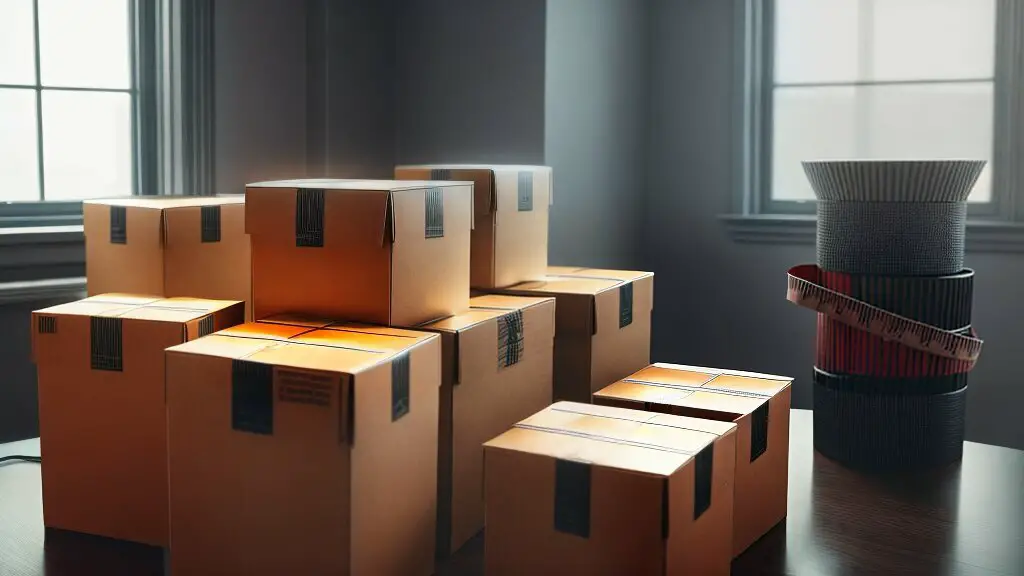If you’re a shoe lover or simply looking to keep your footwear organized, the size of a shoe box can play a critical role. Knowing the dimensions of a shoe box can help you choose the correct package for your shoes, whether you’re storing them in your closet or shipping them to a new location.
Shoe boxes come in various sizes, and understanding their dimensions is essential to ensure your shoes fit properly and are adequately protected. In this article, we’ll explore the different dimensions of a standard shoe box, provide a shoe box size guide for different types of footwear, and offer tips on organizing and maintaining your shoe boxes for longevity.
Key Takeaways
- The size of a shoe box is essential for proper shoe storage and shipping.
- Standard shoe boxes come in various dimensions in inches and centimeters.
- A shoe box size guide can help you choose the correct box for different shoe sizes.

Understanding Shoe Box Dimensions
Knowing the dimensions of a shoe box is essential for practical storage. The standard size of a shoe box varies depending on the type of shoes you intend to store. However, most shoe boxes fall within the range of 13-14 inches in length, 7-8 inches in width, and 4-5 inches in height.
Shoe boxes are typically measured in inches or centimeters. The size of a shoe box is subject to variation based on the type, size, and brand.
Understanding Shoe Box Dimensions in Detail
Shoe boxes come in different shapes and sizes depending on the manufacturer. However, there are standard sizes that most shoe boxes adhere to. Below are the typical dimensions of a traditional shoe box:
| Shoe Size | Box Length (inches) | Box Width (inches) | Box Height (inches) |
|---|---|---|---|
| Women’s size 5-7 | 11-11.5 | 6.5-7 | 4.5 |
| Women’s size 8-10 | 12.6-13 | 7.5-8 | 4.5-5 |
| Women’s size 11-13 | 13.4-13.5 | 8-8.5 | 5 |
| Men’s size 5-7 | 12-12.5 | 7-7.5 | 4.5 |
| Men’s size 8-10 | 13-13.5 | 8-8.5 | 4.5-5 |
| Men’s size 11-14 | 14-14.5 | 9-9.5 | 5-5.5 |
The measurements may differ depending on the brand and style of the shoe. Always measure the shoe box for accuracy before using it for storage.
Shoe Box Size Guide
Shoe boxes come in various sizes to accommodate different types of footwear. It is essential to know the standard dimensions of a shoe box. The average shoe box dimensions in the United States are 13.1 inches long, 7.7 inches in width, and 4.5 inches in height.
However, these dimensions may vary depending on the shoe brand, style, and size. Therefore, it is crucial to measure the shoes to ensure the correct fit for storage. Below is a shoe box size guide to help determine the appropriate shoe box size for different types of footwear:
| Shoe Size | Length (in) | Width (in) | Height (in) |
|---|---|---|---|
| Women’s | 11 | 7 | 4 |
| Men’s | 13 | 8 | 5 |
| Children’s | 7 | 3.5 | 2.5 |
If you need to convert shoe box dimensions from inches to centimeters, multiply the length, width, and height by 2.54.
It is also beneficial to consider purchasing shoe boxes in different sizes to accommodate various types of footwear, such as high heels, boots, sandals, and sneakers. Utilizing the appropriate shoe box size can help maintain the quality and condition of the shoes, prevent damage, and maximize storage space.
Choosing the Right Shoe Box for Shipping
When shipping shoes, selecting the right size and type of box is crucial to ensure your shoes arrive safely and in good condition.
Most shipping companies have specific size requirements for shoe boxes, so checking these guidelines before choosing a package is essential. The standard size for shipping shoes is 13.5 x 7.5 x 4.5 inches, but this can vary depending on the shipping company.
When selecting a box, opt for a sturdy cardboard box that can withstand the rigors of shipping. Make sure the box is manageable for the shoes, as this can cause the boots to shift during transit and result in damage.
When shipping shoes, it is essential to use appropriate protective materials such as bubble wrap or air pillows. Securely seal the box with packing tape and label it clearly with the shipping address and contact information.
Considerations for Protecting the Shoes During Transit
In addition to selecting the right box size and type, key considerations must be considered to protect the shoes during transit.
If the shoes are delicate or prone to damage, consider wrapping them in tissue paper or a protective covering before placing them in the box. It’s a good idea to store your shoes in a plastic bag to protect them from moisture and dust.
When packing the box, place the shoes with the soles facing down to protect the uppers from getting scuffed or damaged. Make sure to fill any space in the box with packing materials so the shoes do not move during transit.
Tips for Organizing Shoes in Shoe Boxes
Shoe boxes can be a lifesaver when keeping your shoes organized, but it’s essential to use them effectively to maximize their potential. Here are some tips on how to manage your shoes in shoe boxes:
Label Each Shoe Box
Labeling your shoeboxes can save you time and frustration when searching for the right pair of shoes. Use a label maker or write the shoe type and size directly on the box to avoid confusion.
Stack Shoe Boxes for Space Efficiency
Maximize your storage space by stacking shoe boxes on top of each other. Be sure to stack boxes of similar sizes together, with the heaviest ones on the bottom, to avoid crushing the shoes inside.
Use Different Sizes of Shoe Boxes
Shoe boxes come in various sizes, so using the appropriate box for each pair of shoes is essential. Heels and boots may require a larger package, while flats and sandals can be stored in smaller containers. Using the correct size box can also prevent unnecessary creasing and shoe damage.
Organize Shoes by Occasion or Color
Organizing your shoes by occasion or color can make finding the right pair for a specific outfit or event easier. You can also group shoes by season, style, or frequency of use to make your shoe collection more manageable.
Consider Clear Plastic Shoe Boxes
Clear plastic shoe boxes can be a great alternative to traditional cardboard boxes. They allow you to see the contents inside without opening each box and are stackable for easy storage. Plus, they’re durable and easy to clean.
Use Shoe Box Inserts
Inserts such as tissue paper, bubble wrap, or cardboard can be utilized.
Shoe Box Alternatives for Storage
While shoe boxes are a popular and practical storage solution, they may only sometimes fit everyone’s needs or preferences. Fortunately, there are several alternative storage options available for shoes.
Clear plastic boxes are a popular alternative to shoe boxes, offering visibility and protection. These boxes come in various sizes and can be stacked for efficient storage. Shoe racks are another option, especially for those who prefer to showcase their shoe collection. These racks can be freestanding or mounted on a wall and come in various materials such as wood, metal, and plastic.
Hanging organizers are perfect for those with limited floor space. These organizers can be hung inside a closet or on a door, typically with several compartments for shoes and other items. They come in various materials and designs, including fabric, plastic, and bamboo.
For environmentally-conscious people, repurposing items such as wine boxes or milk crates can be an eco-friendly and budget-friendly alternative to shoe boxes. These items can be easily customized and decorated to match any room decor.
Shoe Box Alternatives Table
| Storage Option | Materials | Pros | Cons |
|---|---|---|---|
| Clear Plastic Boxes | Plastic | Visibility, Protection | Not stackable, Limited sizes |
| Shoe Racks | Wood, Metal, Plastic | Display, Variety of sizes and designs | Requires floor or wall space, Limited protection |
| Hanging Organizers | Fabric, Plastic, Bamboo | Space-saving, Multiple compartments | Difficult to access, Limited protection |
| Repurposed Items | Wine boxes, Milk crates | Eco-friendly, Customizable | Limited sizes, Limited protection |
Ultimately, shoe storage solutions depend on individual needs, preferences, and available space. When selecting the right option, it’s essential to consider factors like protection, visibility, and accessibility.
Creative Uses for Shoe Boxes
Shoe boxes are not just for storing shoes! With some creativity, these boxes can be transformed into organizers for various items or even repurposed for DIY projects.
Organizational uses
One way to repurpose shoe boxes is to use them as drawer dividers to organize smaller items. Cut down the sides of the box to the desired height, then place it in the drawer and fill the compartments with socks, underwear, or any other items that tend to get jumbled together.
Shoe boxes can also be used to organize craft supplies or office supplies. Label each box with the contents and stack them on shelves or cabinets for easy access.
DIY projects
Get creative with shoe boxes and transform them into unique and functional pieces for your home. Use a shoe box as the base for a homemade gift box, decorate it with wrapping paper, and add a ribbon for a personalized touch.
Another fun DIY project is to transform shoe boxes into wall art. Cut out the sides of the box to create a 3D shape, then paint or wrap the boxes with fabric to match your decor. Hang them on the wall for a chic statement piece.
Eco-friendly initiatives
Shoe boxes can also be repurposed for eco-friendly initiatives. Use them as compost bins for food scraps or planters for starting spring seedlings. They can also store and organize recyclable materials before taking them to the recycling center.
With a bit of imagination, shoe boxes can be used for much more than just storing shoes. Try out some creative uses and see how versatile these boxes can be!
Maintaining Shoe Boxes for Longevity
Properly maintaining your shoe boxes can increase their lifespan and keep them in good condition for future use. Here are some tips to help you care for your shoe boxes:
- Store shoe boxes in a dry, relaxed environment to prevent warping or damage from moisture.
- Clean the outside of shoe boxes regularly with a sponge, mild soap, and water.
- Avoid harsh cleaning agents to prevent damage to the box or label removal.
- Protect shoe boxes from pests such as moths and mice by storing them in sealed containers or placing mothballs or lavender sachets inside.
- Avoid stacking heavy objects on shoe boxes to prevent crushing or deformation.
“Taking care of your shoe boxes can help them last longer and keep your shoes organized and protected.”
By following these maintenance practices, you can ensure your shoe boxes are in good condition when you need them for storage or shipping.
Benefits of Using Shoe Boxes for Storage
Using shoe boxes for storage offers numerous benefits beyond just keeping your shoes organized and easily accessible.
- Protection: Shoe boxes protect your shoes from dust, moisture, and other damaging elements. Storing shoes in containers keeps them looking new for longer.
- Space-saving: Stacking shoe boxes saves space in your closet or storage area, allowing you to store more shoes in a smaller space.
- Customizable: Shoe boxes come in different sizes, allowing you to choose the appropriate size for each pair of shoes. You can also label each pack, making it easy to find the boots quickly.
- Aesthetically pleasing: Organizing your shoe collection in boxes creates a tidy and polished look. It not only makes finding your shoes easier but also enhances the overall appearance of your living space.
- Reusable: Shoe boxes can be repurposed to store other items, such as jewelry, socks, or keepsakes. By reusing them, you are reducing waste and contributing to a sustainable lifestyle.
By utilizing shoe boxes for your storage needs, you keep your shoes organized and well-maintained and create a functional and eye-pleasing storage solution for yourself. It’s an easy and cost-effective way to maintain order and make a space-efficient and tidy living environment.
Conclusion
In conclusion, understanding the dimensions and measurements of a standard shoe box is crucial for the adequate storage and organization of footwear. By utilizing the appropriate shoe box size for each type of shoe, you can protect them from damage, keep them easily accessible, and maintain a tidy living space.
Shoe boxes are practical for storing shoes and offer versatility in repurposing for other storage solutions and DIY projects. However, it’s essential to properly maintain them by keeping them clean, dry, and protected from pests and moisture to ensure their longevity.
Overall, the benefits of using shoe boxes for storage cannot be overstated. By understanding shoe box dimensions and being creative, you can organize better and transform your living space.

I’m Telma Janda, and I bring experience in store management, storekeeping, and interior decor to the table. Hailing from the Lone Star State of Texas, USA, I’ve spent years delving into the intricacies of organizing spaces and making them functional and visually appealing.
Having managed various stores and honed my skills as a meticulous storekeeper, I understand the nitty-gritty of space optimization and inventory control like the back of my hand. My journey through the world of interior decor has given me a keen eye for arranging spaces in aesthetically pleasing and practical ways.
Through my writings, I share actionable tips and insights on BestStorageBoxes.com to help you master the art of effective storage and enhance your living spaces. From decluttering to creating stylish storage solutions, I’ve got you covered. So, let’s embark on this journey together and transform how you manage your spaces.
Stay organized
Telma Janda
